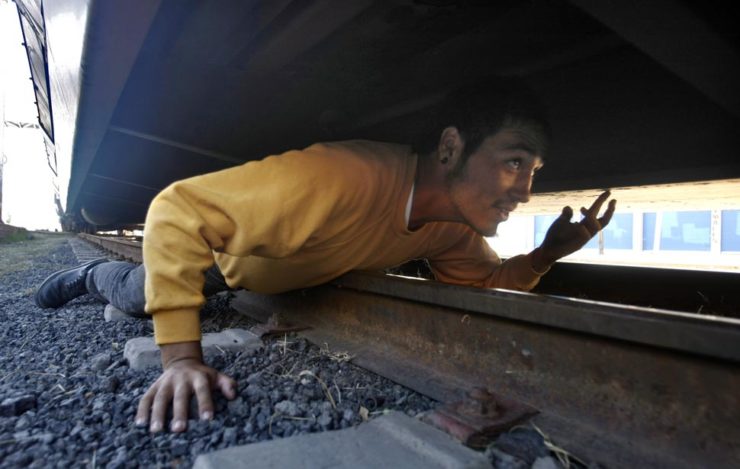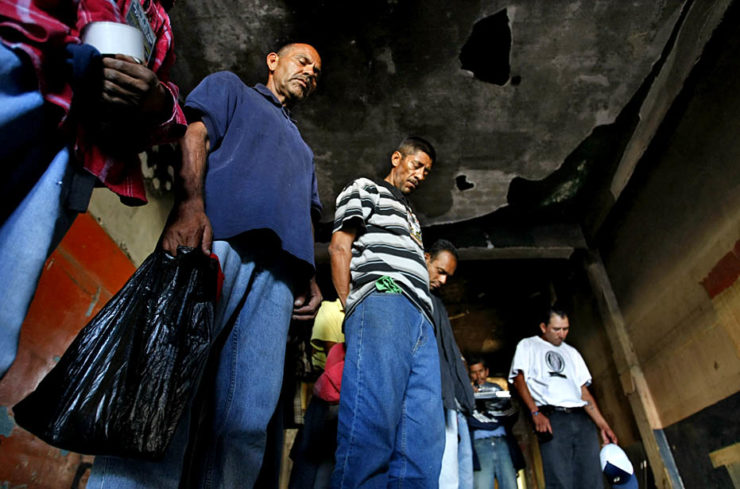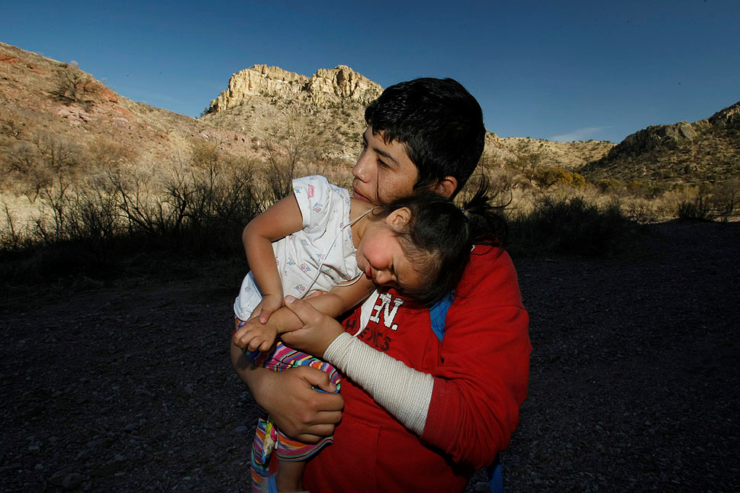Stories about anti-immigrant raids and deportations can take on a sheen of the generic: a series of action-movie snapshots coupled with thousand-foot views of policy, statistics and ideology that tackle the facts but miss the eye-level truth.
As conversations about undocumented immigrants erode into partisan debates and decisions about many thousands of futures are reduced to bargaining chips, it’s also easy to lose sight of what stories have come before, when readers were perhaps paying less attention. Richard Marosi of the Los Angeles Times has been on the border beat for more than a dozen years; he shared his take on how to get it right.
"As a result of bad public policy, there’s a lot of distortion of what is actually happening on the border right now by politicians. So I just try and capture the reality of it as best I can, and listen, and represent all sides."
The six stories in the “Without a Country” series, for which Marosi became a Pulitzer finalist, are satisfyingly distinct in a sea of generalizations. Even six years later, they feel as immediate as when they were published.
In one, Marosi watches a 20-year-old try to catch a train going over the border by clinging to its underbelly. In another, U.S. citizens turned back from an immigration checkpoint sell pieces of the dismantled border wall for scrap metal to pay a smuggler for passage home. In a third, a man snagged by mistaken identity sees his daughters slip away to American parents as his attempts to rejoin them in the States are rebuffed again and again.
Though the narratives are gripping and Marosi’s storytelling cinematic – and the situations he writes about often extreme or barely believable – the specificity of the voices and experiences preserves his subjects’ uniqueness without losing sight of their universality.
I recently spoke by phone about how Marosi found the stories in “Without a Country” and what reporters still miss about border stories. An edited transcript of our conversation follows.

Can you tell me a little bit about how this project got started? Did you know you were starting a series?
I'd been covering the border for several years already. Like so many of my other projects, this just came about with serendipity. I was working on a story about an ICE [Immigration and Customs Enforcement] program that shuttled immigrants to other parts of the border to kind of slow or break the cycle of deportation and return. I was hanging out in Mexicali late one night, and there were just hordes of immigrants crossing, and then they started telling me their stories. This was at a time when the Obama administration was deporting about 400,000 a year. The statistic was out there, but no one really had followed up on what happened after these folks were deported.
I went to the Hotel of the Deported down there in Mexicali, and you walked in there and it felt like a displacement camp. This carpet of people all along the big corridor. I thought, oh my God, this is unbelievable. That was my first inkling that there was a bigger series out of this, that I could do a collection of stories. And one grew out of the other, and it turned into a six-part series from different parts along the border.
Because I've been covering immigrant stories for years, I had a high threshold for them. It's got to be something new, because you talk to most immigrants, they have incredible human tales. So unless they tell me something new about the border, I'm not going to write about it. Hanging out at that hotel, talking to hundreds of immigrants, it was jaw-dropping stuff. I couldn't believe what was spilling out from these guys. I thought I'd heard every single immigrant story. And I thought, oh my God, this is big. This is amazing.
"Every time you humanize Mexican immigrants, it’s inevitable that you’re going to get a lot of hate mail. Anything that kind of tells a story from their perspective, or reaches out and includes perspectives of the folks that are most affected by immigration policies. There’s a lot of hate out there. The job is getting it all right."
The first story I did was about this kid, Luis Luna, and that came about just from hanging out in Nogales and stumbling upon it. I couldn't believe his story.
I had no idea that he’d be back in the U.S. when I was checking up with him over the years, and then he finally got to L.A. and told me the story. That last story left out a big chunk. He almost died. It was an epic in itself. We all know those terrible, you know, struggling immigrant stories about crossing the border. And his was so harrowing. I wrote it up, but we decided – there's not much new here. So we took all that out and focused on how he was living in L.A., his job, back living in the shadows of the United States but happy – we thought that was worthy of another story.
And it just came together that while I was interviewing Luis at that shelter in Nogales, I was talking to a lot of other immigrants, and I saw this skinny 12-year-old kid who spoke perfect English. That was the other Luis. He was telling me he was living on the streets with his grandma, they had no money, and he was such a nice, sweet kid. He told me they couldn't get back into the country – he was a U.S. citizen and they couldn't get back in the country. I couldn't believe it. About a month later, I called him, and he picked up. He said, “We made it to Nogales. We were smuggled in to get back into our own country.”
Can you tell me more about how about the fact-checking side of all this? You’re reporting stuff in these stories that seems like it may be tough to verify sometimes.
When I met Luis Luna and he was telling me this incredible story of his life in Washington – he used to be an Abercrombie and Fitch model in high school, played basketball – he's telling me all this stuff, but I'm just a hard-boiled skeptical journalist. The first thing I did before I spent a lot of time on that story was call the principal at his high school.
Basically, everything checked out. Otherwise, you just don't have time. I don't want to waste my time to find out this kid has a long record and it's not going to be as riveting a story. Part of the reason why his story connects is because it's because he's so sympathetic, he did nothing wrong!
So I have to do that very early on so I can use my time effectively down there, because whose story are you going to tell? There's hundreds of immigrants. Early on, you've got to confirm this guy's for real.
And then we almost watched him die trying to catch that damn train. That was terrible. I had nightmares. I thought we would witness his death.

What was reporting that part of the story like?
We were there just observing, and he was going to try and cross. You know, the train stops, and he's trying to get on, and he couldn't. But for a few moments there, I thought, oh my God, if he doesn't get in there or he slips, falls, we're going to watch him die. It was terrifying. He was going to go again the next day, and I was really worried for him. And luckily – I say luckily – there were police or train security guards who shooed us away. And I was really relieved. It would have been horrible.
Were you on a different beat before you began reporting so much on the border?
I was covering southeast L.A., mostly dealing with corruption. My stories contributed to more than a dozen politicians being jailed or indicted. I didn't set out to be an investigative reporter, but that's what usually ends up happening on my beat. These are more feature stories, but meaty feature stories. I like feature stories that tell you something with news value. I mean, people conveniently forget, but Obama was the “deporter-in-chief”! Even Trump has acknowledged that.
What have you noticed as far as how things have changed since then in the type of coverage that these issues get?
It's difficult, because we're out there doing these stories every day, but it’s not reaching a lot of America. It’s hard to get the truth across about what's going on. Much of America thinks the border is totally out of control, it must be dangerous – but the reporting doesn't bear that out. But every time you humanize Mexican immigrants, it's inevitable that you're going to get a lot of hate mail. Anything that kind of tells a story from their perspective, or reaches out and includes perspectives of the folks that are most affected by immigration policies. There's a lot of hate out there. The job is getting it all right.
In the current political climate, what’s lacking in coverage of immigration and the border? What motivated you to dig into this beat?
Well, it's always been lacking. Most reporters go down there, they parachute in, parachute out. They don't really know the border very well, so they recycle stories.
I didn't intend to cover the border initially. I didn't come in as an advocate. I just came in here to do stories and illuminate as best I can the realities of the border.
And it was a lot different than I thought it was going to be. Covering the border is covering the lives of people who try and cross the border all the time. They're human beings. They're suffering. They have hard lives. The vast majority are hardworking – the stats bear that out. They're not murderers, they're not drug smugglers for the most part. So as a human being, you can't help but be touched by their struggles.
I've also written about the bad guys. And I've also written about the great efforts of the Border Patrol and the DEA to oust the real bad guys, the smugglers, the people that take advantage of most of the people on the border. So there are bad guys and there are good guys on the border.
But for the most part, it's pretty gray. And there's a lot of human suffering on the border. As a result of bad public policy, there’s a lot of distortion of what is actually happening on the border right now by politicians.
So I just try and capture the reality of it as best I can, and listen, and represent all sides.



